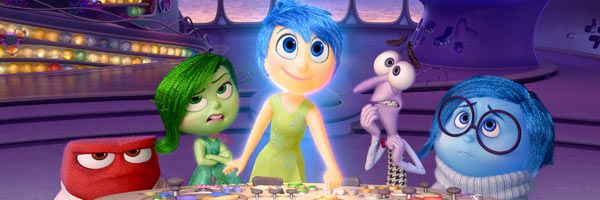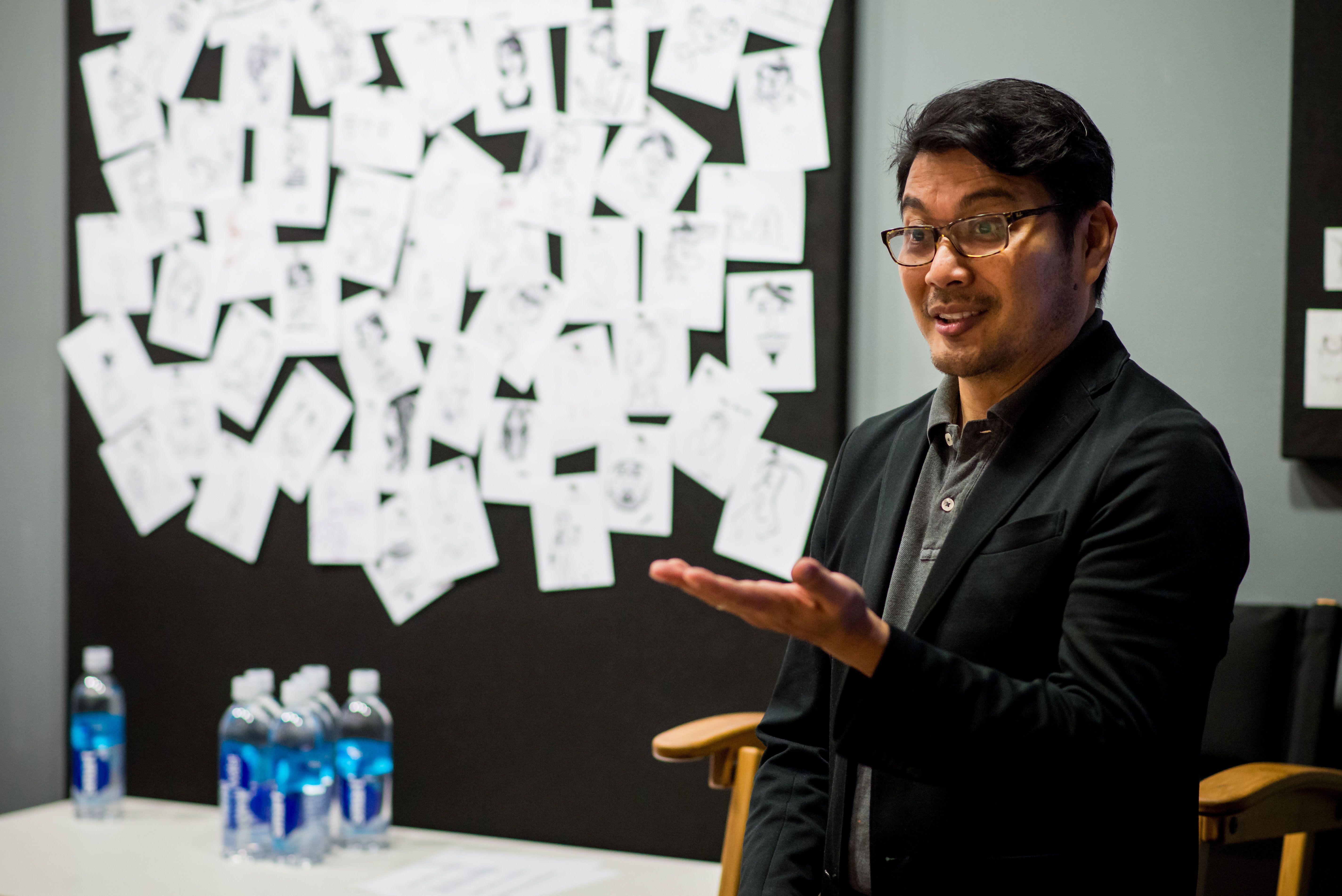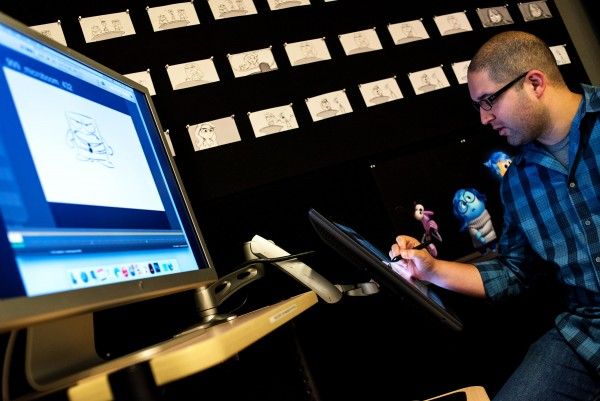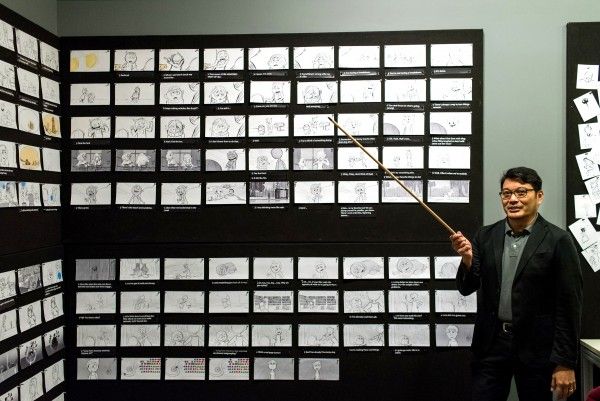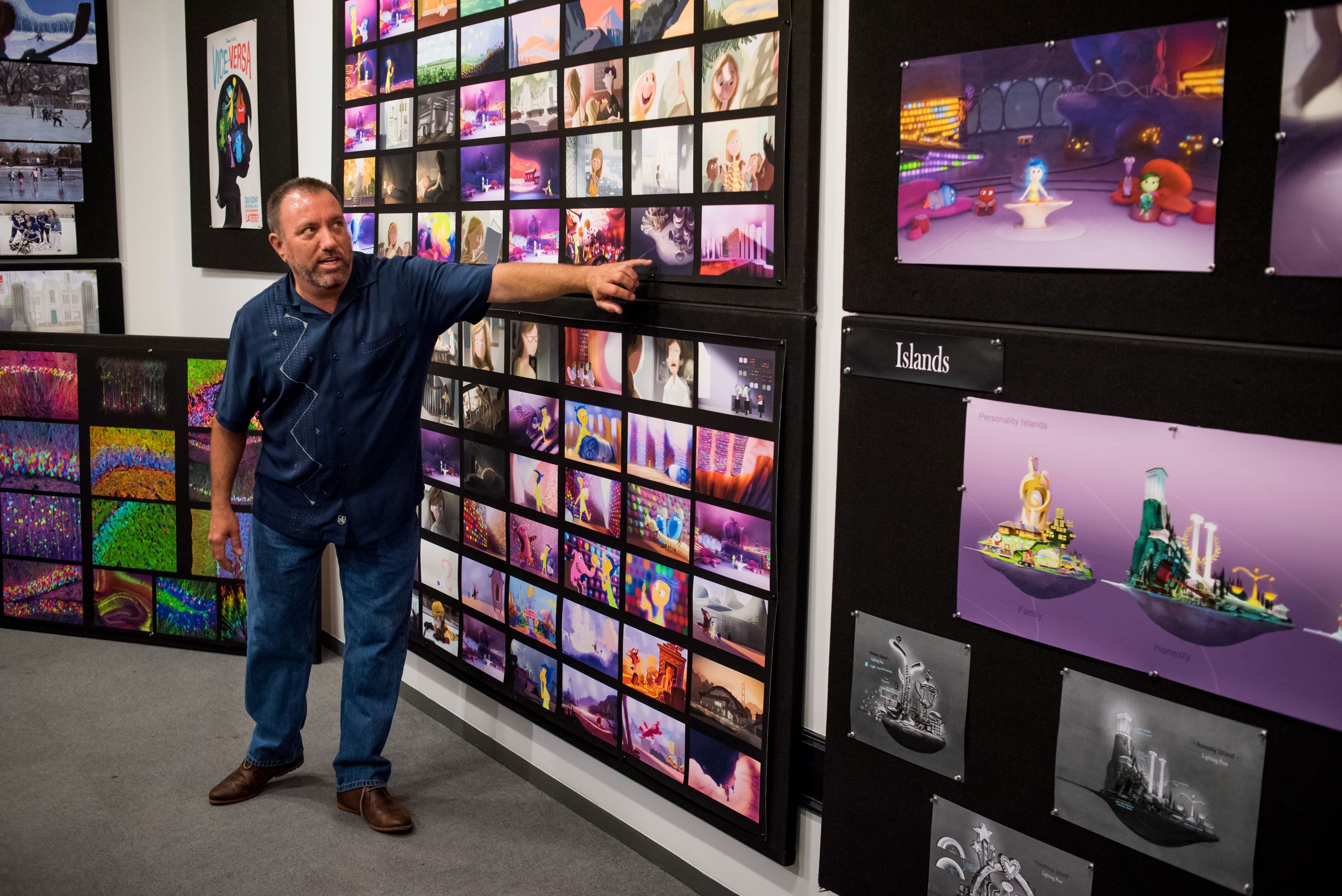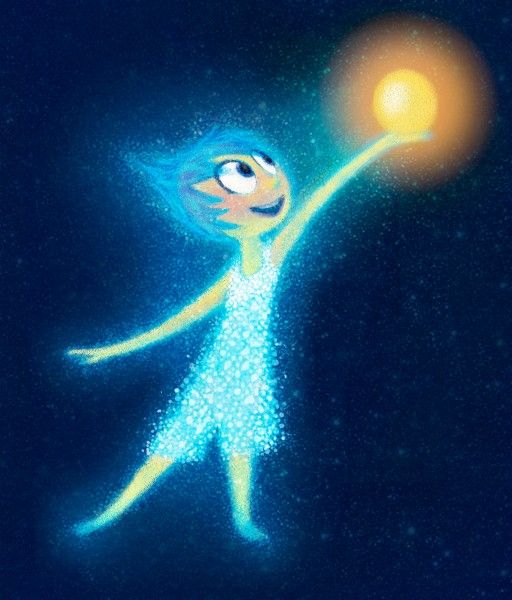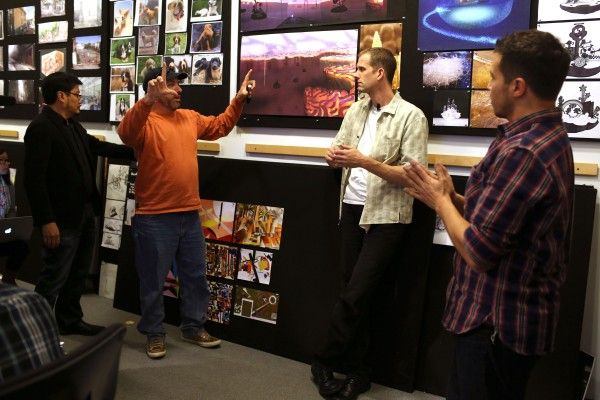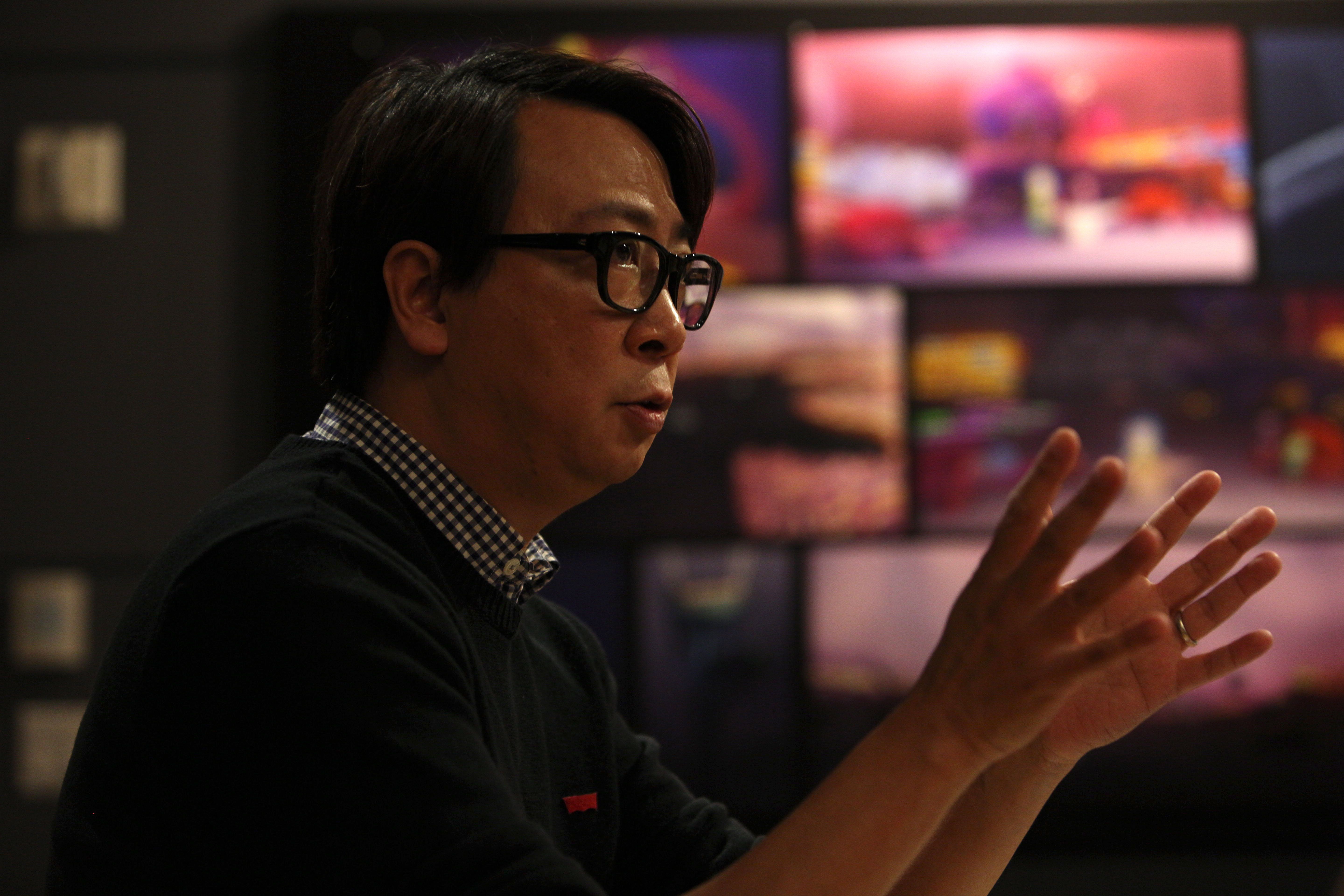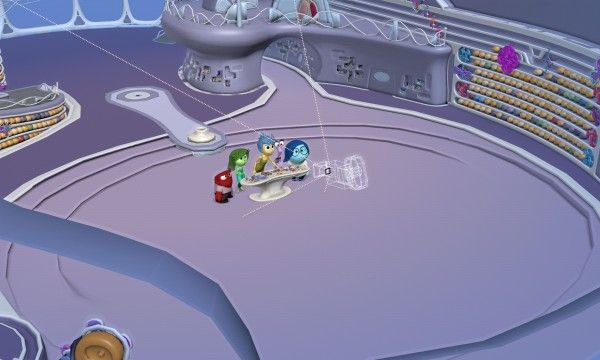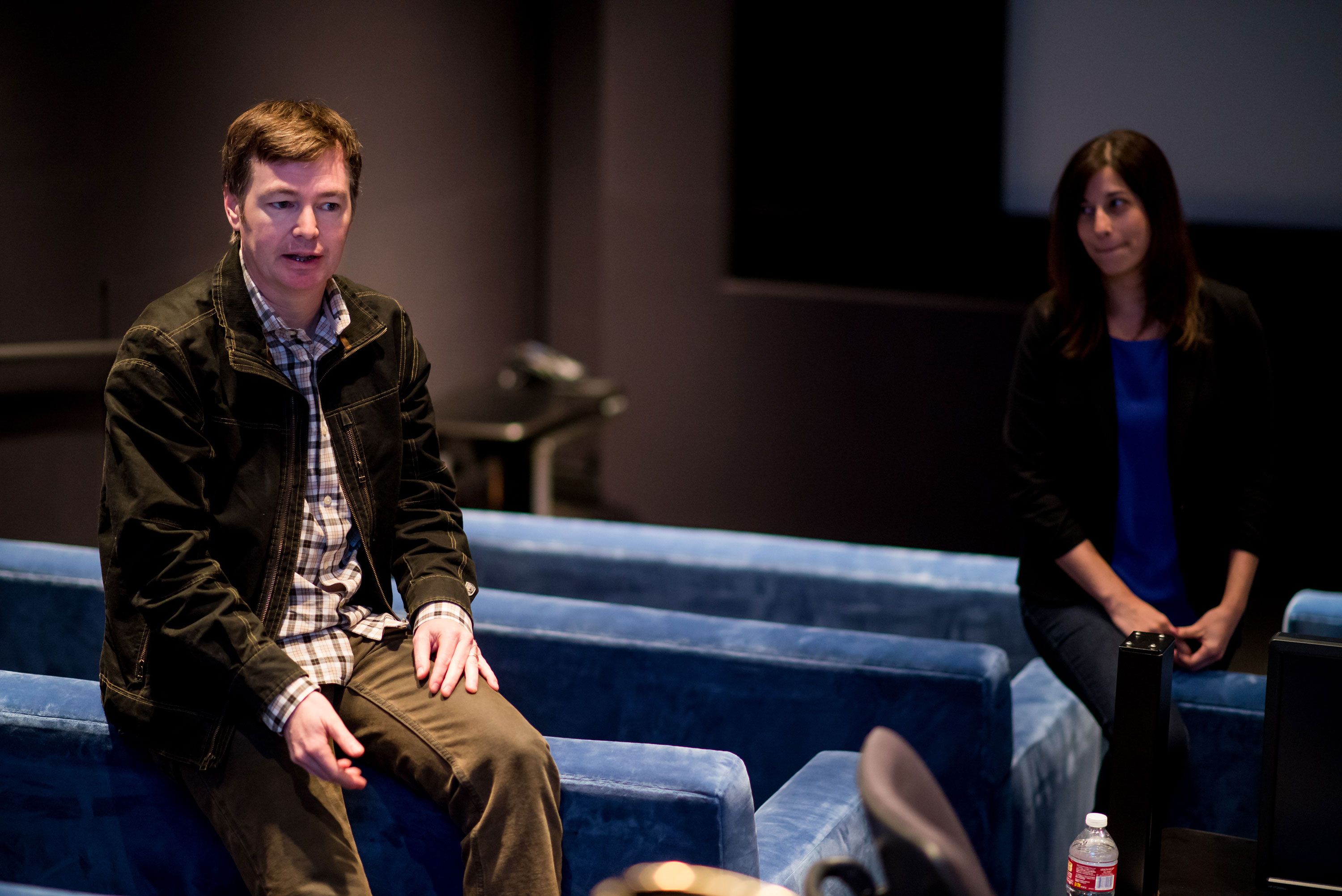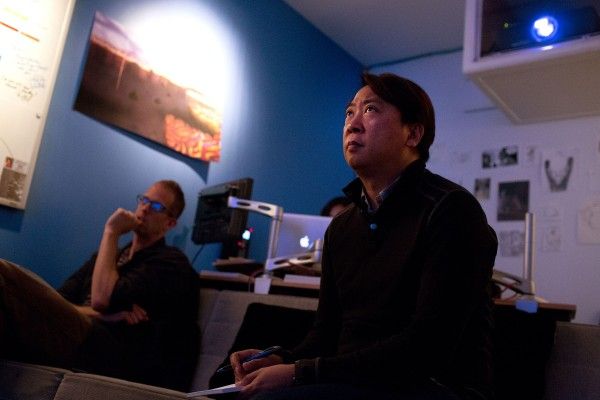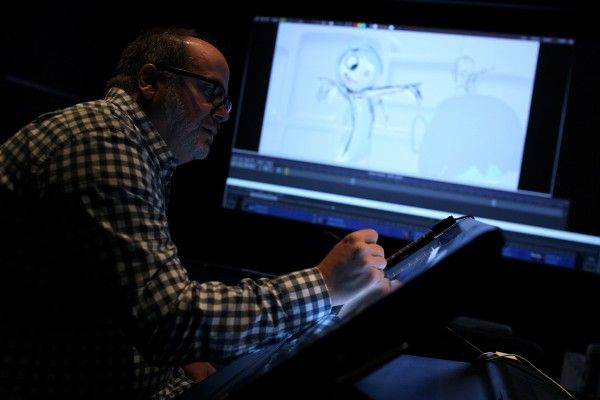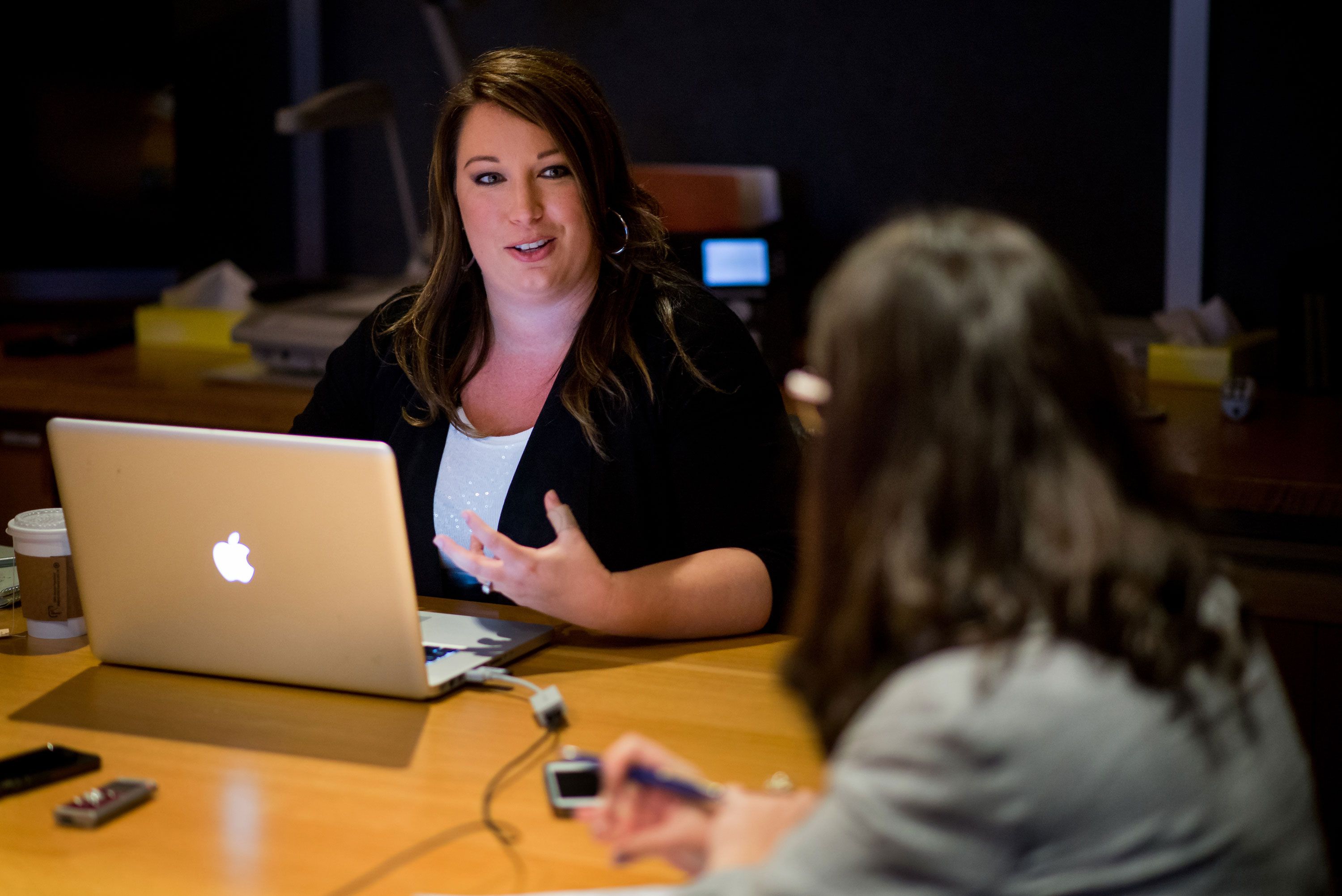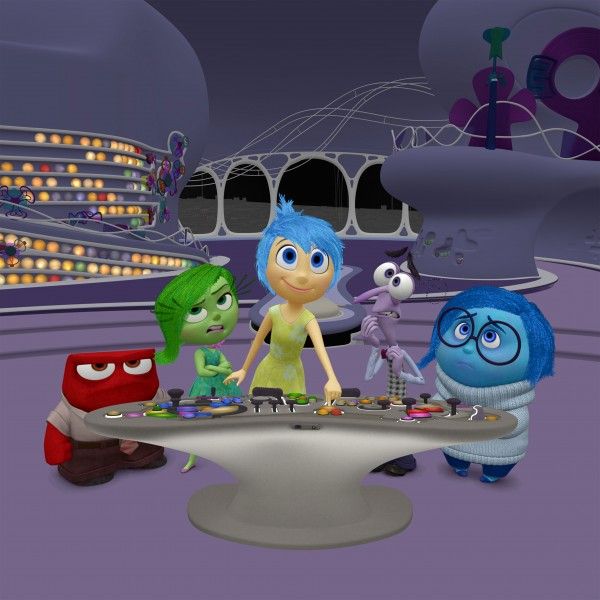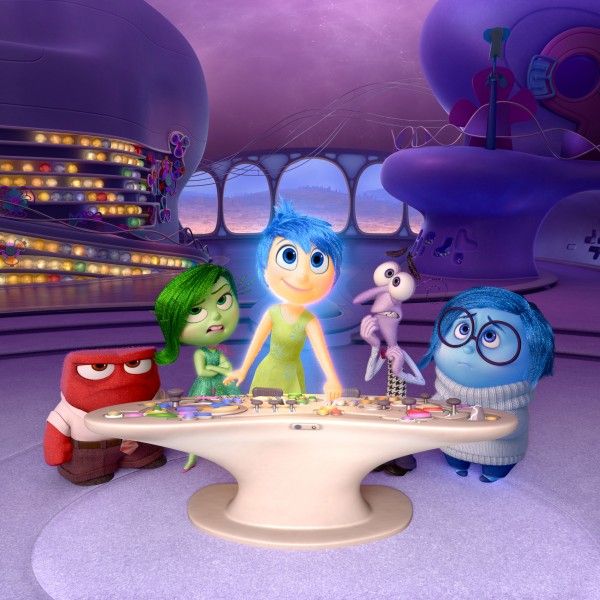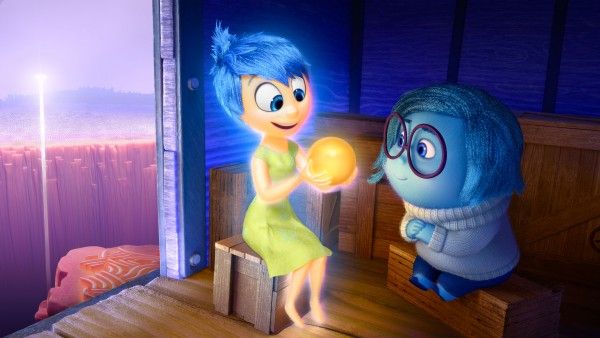It’ll never cease to amaze me how many people and how much time goes into making a feature film, but while visiting the Pixar campus in San Francisco back in April, I got the opportunity to get an especially in depth look at what it took to make Inside Out and it’s an absolutely mind-blowing process. The day after screening the first hour of the movie, we got the opportunity to participate in five presentations - one for the story department, one for production design, one for layout, one for animation and one for the lighting department. Each gave us a play-by-play of what they do on a daily basis covering the technical and creative requirements of their jobs, showing examples of their work and how the material changes over the course of production, and tons more.
Warning: This is a long one, but it was hard enough to keep this piece from being double the length because there were so many fascinating things that had to be done in order to bring Joy, Sadness, Disgust, Anger, Fear and Riley herself to life on screen in the most effective way. Here are 39 things to know about the process of making Inside Out broken down by department:
Story with Co-Director Ronnie del Carmen
1. This is where it all begins. “When it starts, there’s barely anything.” Del Carmen continued, “What we have is a fantastic concept. Pete Docter says, ‘I want to make a movie about an 11-year-old girl and the featured players are the emotions inside her head.’ ‘Of course! Let’s start!’ You go into a room, sit across from each other and then, ‘What do we do?’ We don’t know! We get to figure what that is. So we start workshopping stories. We tell each other stories. ‘What were you like when you were a kid? What are your kids like?’ And then the first thing that shows up is that the lead emotion should be Joy because kids are always happy. They’re always bouncing around. It always feels like they’re always eternally happy.”
2. The ideas don’t always come easy and when they’re stuck, the filmmakers switch gears and start drawing each other. “There will be whole days, maybe even weeks where everything you try fails and then you’re sitting across from each other kind of out of bullets.” Del Carmen pointed out some sketches of a few very familiar faces hanging on the wall including himself, Jonas Rivera and Pete Docter. “It’s fun. It kind of breaks you out of that problem solving mode.”
3. What does a story artist do? “As a story artist, you get to draw a simple version of the character because you have to draw them hundreds of times a day. Hundreds, about 300, 400 drawings a day, maybe for a sequence, maybe for part of a sequence.” Obviously if you’re doing that many drawings a day, you’ve got to be able to do them fast.
4. Sketching Anger. Del Carmen gave us a step-by-step demonstration of how to draw Anger. It might be tough to visualize without getting to see del Carmen run through the process yourself, but here are the steps if you want to give it a go:
- Start by drawing a square.
- For his eyebrows you need “an arc that goes up at the top, and then you draw two lines that represent his brows.”
- Now put in “crescents for his eyes” and “the iris right at the top.”
- “His mouth is the opposite of that other arc.”
- Now for the top of his shirt, and “after that, you can draw these little triangles for his collar.”
- “In between that, you can draw his tie.”
- “The top of his pants actually go behind that tie.”
- “His arms are kind of like these little dangly tubes with fists.” The fists are small circles at the end of each arm.
- “Underneath that square you can draw his shoes" and "then you can just draw two lines to make sure that it looks like he has legs.”
- “And if you want to feel like he’s really glowering, you have these lower lids you can draw" and "after that, you can put smoke above his head like he’s really burning up.”
5. How to get a pitch approved. “You would draw the beginning, middle and end of [a scene] and then you, as the story artist, would stand in front of it or in front of a digital screen and pitch it.” As an example, del Carmen stood up and essentially acted out an entire scene, voicing each character himself, while pointing to the appropriate storyboards. (It was insanely entertaining! Honestly, I could have watched him act out the entire movie.) “You pitch something like that, you find out if it works. If it works, it stays. If it doesn’t, you have to do it again.”
6. Writing the script was a very collaborative process. “Pete and I would be talking to each other, pitching stories to each other.” Del Carmen continued, “We write our ideas down and it looks like a script, it behaves like a script, but there was no one who’s in charge of - we don’t write a movie where somebody in some special room, a genius writer room, writes all three acts and it’s perfect and then hands it to, ‘Please illustrate my genius.’ No. That doesn’t happen.” He further explained, “Our writing process is about trying something whether it’s drawn, written or just pitched along the halls. That’s how it’s done. We’re not just waiting for, ‘Ah, I wish some genius would come and write this movie.’ No, that would be us in a room like this.”
Production Design with Ralph Eggleston
7. What does Eggleston do? “I’m usually one of the first people on the film, one of the last people off, and it’s to build a team to visualize the film. We work with the director and story to put in place visuals that can tell this story. We’re not just an adjunct. We don’t just design stuff for the story. We’re part of the storytelling process from the get-go.”
8. Drawing inspiration from “brainbows.” “What they are is actually slices of brain tissue that have been injected with chemicals that emit a certain color under different lights and you’re able to see different layers of neurons.” He continued, “The film is not set in the brain, it is set inside the mind, but we didn’t really want to deny ourselves some of the visual cues that the audience might understand from the physical aspects of your body.”
9. The Real World vs. The Mind World. “We wanted the humans to be slightly on the more real side for this film because if we’re gonna go that cartoon-y with these guys, we kind of had to find the balance.” Eggleston added, “The audience needed to know pretty quickly where you were when you cut from the inside of the mind to the outside of the mind.” As for the locations themselves, Eggleston pinpointed a few features that would be Real World-specific and others that would be Mind World-specific. Keep an eye out for lots of texture and very low contrast in the Real World. However, in the Mind World, you’ll see “a lot of saturated color, very high contrast and lots of translucent and light emittive surfaces.”
10. How they came up with the idea to make Joy effervescent and why the other emotions couldn’t have that same effect. “The idea actually came from a sparkler.” He continued, “We worked on the idea of her being effervescent or sparkly for about eight months and it got to the point that we couldn’t afford to do it. There was no way. And then we showed John Lasseter and he goes, ‘That’s great!’ None of the other characters had it because we just couldn’t afford it. When John saw it on Joy, he goes, ‘That’s great! Put it on all the characters.’ You could hear the poor technical staff just hitting the ground and the budget flying through the roof.”
11. What’s a color script? “The color script is a visual shorthand showing light and color and texture in lighting and costumes and hair. It’s part of the design process.” He continued, “It’s a shorthand version of the storyboards, but dealing with color and light and staging and cinematography and contrast. One of the things about it you can see is when we cut from the Mind World to the Real World the big differences between the color palettes.”
12. The Personality Islands weren’t always islands. At one point, they were Personality Pillars. “This idea changed considerably as well through the course of production because they were once pillars, then they were floating up in the sky. It was crazy how much it changed.” He further explained. “The idea was, if Riley had been interested in music instead of hockey for a couple of weeks, like, ‘Oh, I wanna play the tuba,’ you know? And so music island might have started growing and if she had become really interested in it and become the world’s greatest tuba player, it might be the biggest island in her mind. But then she loses interest in it and it kind of fades away.” He continued, “The idea is that they’re already there, they can be there, but that you can build on them, you can improve them yourselves. You have to do it yourself though. You have to make the decision to improve it.” He added, “And of course as she starts losing interest in each of those elements, they start going down both color-wise and value-wise, and then literally start collapsing.”
13. The color of the sky reflects Riley’s mood. “It just gets darker over the course of time through the film. It’s a simple idea, but it’s a getable idea without having to state too much. And we didn’t want to go so far as to suggest that Riley was sinking into some sort of major depression. There were versions of the film where it kind of tended to go that way and we kind of kept pulling back because that’s not what the story’s about, you know? The story’s really about Riley just adjusting to a new world.”
14. The Train of Thought was once much more prominent in the film. “The catenary wires and all the supports and the train tracks being everywhere, we could make it look good in one image, but when the camera started to move and we had all these different shots, it just got too busy everywhere and we didn’t want that. It had to be clear that they were going back up to headquarters. So we came up with this idea that the train track could appear and disappear in front and behind the train. The idea there being, again, electrochemical, that it’s all about energy and light and translucency and sparks.” However, they did have one rule. “The only rule we had is that it could go anywhere in the mind because the track can appear anywhere, but if it came to a stop, it had to go to a train station, and we had originally multiple train stations through the mind. I think it got whittled all the way back to one.”
15. Here's one big change to look out for in international cuts of the film. “The biggest one will be when you’re in dad’s mind. Internationally I think they’re watching football and here they’re watching hockey.” At one point, they also toyed with the idea that different colors mean different things in different cultures, but they had to let it go. “We explored the idea of changing that, we even explored the idea of them changing color for a day maybe, but, you know, we had to strip it down, simplify.”
16. Eggleston won’t be able to truly enjoy watching Inside Out for a number of years. “It’s unfair because now I see it and all I see are the parts. I can’t see it as a movie yet so I don’t know if it works.” He continued, “It’s not fair because five years from now will be the first time I can actually sit back and actually watch it for what it is.”
Layout with Director of Photography Patrick Lin
17. In animation, it’s not lights, camera, action. It’s camera, action, lights. Lin explained, “In other words, first it’s layout, then it’s animation and then is lighting.” He continued, “We are at the front of the production pipeline. We set up the foundation for all the other departments to follow, to put their work on. And we’re also the first step into defining what the film is going to look like cinematically.”
18. They’re very similar to a live action camera crew. “Our main tool is a camera, only our camera is virtual. But although it’s virtual, it’s mathematically true. It has lenses, focal length, focus, f-stop, distortion, depth of field and everything. And we mimic real camera movements as if it’s on a track, dolly, crane, steadicam or handheld.”
19. The layout department is also responsible for staging. “Staging is the choreography of camera and subjects and how we move them through the scenes. We use framing, compositions and blocking to establish movements and positions for both characters and camera.”
20. Lin’s work begins in an empty room. As Lin explained, they start with an empty room, for example, the Mind World headquarters. “The first thing we do is we bring in our camera.” After that, in come the digital characters. When that happens, they’re all in T-shape poses, with their arms extended, because the animation department hasn’t even touched the material yet. Lin continued, “We are also responsible for setting up the initial posing of the character. So now we pose them and I’ve moved them to their starting point, and then now I can move the camera over to get the first close-up of Joy.”
21. Once they figure out all of the story beats, they move on to shot building. “This is the phase where we expand on the blocking and the timing, and then if we need to animate the camera, we also do it at the same time.”
22. Once they’re happy with the camera moves, it’s on to editorial. “That’s when we give all the shots to editorial where all the shots are going to be rearranged, they’re going to be trimmed or expanded, blocking is gonna be refined.” Once that’s done, “that’s the final layout that we deliver to animation.”
23. The difference between the visual language for the Real World and the Mind World. “The idea is pretty simple. The idea is that the outside world is based on real locations, so it should be realistic, it should be imperfect and flawed. The inside world is imaginative, it’s virtual, so it can be perfect.”
- Lens Distortion: “The first thing we looked into to separate these two worlds is lens distortion. Lens distortion is the imperfection in the glass of the lens during manufacturing.” He further explained, “We went to a camera house in Berkley and we rented some real lenses. There were two brands that we rented, the Cooke S4 and the Ultra Prime, and we put up a distortion chart and we shot the chart with each of the lenses and what we found was the Cooke has a more pronounced distortion than the Ultra Prime, so we measured each of the lenses’ distortion curvature and we modeled that into our virtual camera. And this is the first time Pixar has ever modeled a lens based on a real lens.”
- Focus: “In live action a lot of times the focus puller will just miss the focus and it’s a very natural thing for live action, and I like that flaw and imperfection, so I’m gonna use that and put that in the outside and the inside is always spot-on focus.”
- Camera Movement: “We decided for the inside we’re gonna use a more mechanical camera movement with dolly, track, boom or crane, a very controlled movement. On the outside, more organic with zoom, steadicam and handheld cameras.”
24. Lin's team also uses something called extensive camera capture. “This is how we captured unlocked camera. We basically shoot it like a live action. We have animation already and we capture the camera data live.” Lin pulled up a video of a camera operator walking around a room filled with sensors, holding a tripod with a camera mounted on it. He explained, “We’re actually mimicking steadicam move because we don’t have a steadicam.” He also showed us some footage of one camera operator stepping off a ream of paper. Why? “Because the cameraman is stepping off of a curb, so we just need to mimic that motion.”
Animation with Shawn Krause, Victor Navone, Jamie Roe and Tony Fucile
25. What does a directing animator do? Roe explained, “A lot of my role was to provide support to the animators and provide creative and constructive feedback to them while they were working and also to animate on the show.”
26. What do the supervising editors do? Navone explained, “We’re also giving feedback to the animators, doing a very little bit of animation, but one of our big jobs is working with the producer to make sure that animation is staying on track and we’re hitting our deadlines, and we’re also working with other departments to make sure, for instance, that the downstream departments like effects and lighting are getting what they need from animation and that the upstream departments like layout are giving us what we need to animate the shots.”
27. What exactly does the animation department receive from the layout department? Krause tackled this topic. “By the time we get it, story’s done with their job, layout’s taken the storyboards and translated them into sets and put the characters in there and picked shots.” He continued, “And then we’ll get shots and sequences and we’ll cast them out to animators.”
28. All about dailies. Once the animators have their shots, material starts pouring in. This material is called dailies. As Krause explained, “It’s a daily meeting and it’ll happen at 9am and people will sign up through the system for signing up, and it could be five, it could be 20 people. You never know who’s gonna sign up to show their work to the director, and much like a live action film, he’s directing the performance. We’ll come together and it’s really nice for us because unlike I think most studios, we get here and anyone’s opinion is valued and we’ll bat around ideas and we’ll look at the shots and we’re all aware of what people are showing.”
29. Here’s how Pete Docter gives notes during these meetings. A small screening room is packed with people. Someone announces, “Next up is Denovan. He has his IP pass of Joy and Sadness on 53F and 53C.” After watching the material, Docter offers some notes. “Could you move it earlier so that her hand gets there just a little sooner, I’m talking like four, six frames, and then just have it slow at the very end so that we have a little bit more time to read the color change because I’m looking at her and the point hopefully would be that we see, ‘Uh oh, the balloon,’ and I feel like we’re just shortchanging that a bit. But I’ve got nothing on that next shot. Is there any reason why we can’t final this?”
30. The stages a shot goes through while at the animation department:
- According to Roe, the material that comes in from layout is “very crude, there’s not a lot happening, the expressions are way off model, but the whole point is it’s giving information to the animator about staging and props and sets and where the camera is and timing.”
- She continued, “From this stage, the animator tends to get a briefing from the director and he’ll kind of explain what he’s looking for story-wise out of the shot and important beats to remember to put in there, and then the animator tends to also collect their own reference, do their own research, some people act it out in front of a camera, some people do drawings to get ideas.”
-
After collecting all of these thoughts, suggestions and ideas, it’s time to do a first pass. She explained, “Usually that first pass is really rough. You don’t want to spend too much time on the ideas because you don’t know if they're going in the right direction yet.”
- Here’s where Tony Fucile might get to step in. He noted, “Sometimes this early on I might not do draw-overs, but in this particular case there was some good foundation and the idea of exaggerating the poses was something I would play around with.” He pulls up a shot of Joy and essentially traces over the animation, making markings that bring her hand out more and ones that push her chest higher. Navone noted, “It’s just reference. [Tony isn’t] actually effecting the CG models, so it’s up to the animator to try to get the model to do what Tony’s drawings are doing.”
- Roe jumped back in. “The animator would then take all this information, feedback, Tony’s sketches, which they can look at at their desks, and try to get as close to it as possible as a model and do another iteration and when they felt ready, they would then show it in dailies again, the second version, which we call second pass blocking.”
- She noted that there’s many more iterations, but for the sake of time, jumped into explaining what the final version of an animator’s work looks like. When a shot leaves their department, “it doesn’t have the hair animated yet, it doesn’t have the dress movement in there yet. That’s all for the simulation department to do after us.” However, even though key elements were still missing, the final shot was significantly more detailed and refined that the initial version.
31. How long does it typically take an animator to get a shot approved? Navone explained, “This shot’s about five seconds long. It probably took the animator three weeks to do. Maybe a little bit longer than usual because this was a pretty early sequence in production so we were still kind of figuring out how Joy moves so there’s more time for exploration. On average, an animator produces about three seconds a week of final animation. That’s our historical average. It of course is gonna vary depending on how complex the shot is.”
Lighting with Character Lighting Lead Angelique Reisch
32. What Reisch has to do before she can even begin lighting the characters. She explained, “I worked very closely with the art department, with characters department and with the director of photography to basically finalize the look of the characters and the look of their shaders and how that was gonna work. I also worked with the characters department to test the characters just to make sure that technically they were gonna be ready to come into the lighting department and be lit. And then I also served as character support for our lighting team. We had about 35 people so basically if anybody needed help lighting a character or technical support, I was basically that person that they would come to.”
33. What does a lighter do? “Our jobs as lighters on an animated film are actually really similar to the role of a cinematographer on a live-action film, but with one crucial difference - we don’t have to move all those heavy lights around every day thankfully! Our lights all exist in the computer, but what we’re saving on muscle power we’re definitely putting in in brain power because we have to create every single light, every single shadow, every single component completely from scratch.”
34. How lighters approach their assignments.
-
"When we get a new shot, we’ll typically start with a pastel from the art department.” Pastels are the most cost-effective way for the art department to convey their ideas. “They can very quickly get a lot of ideas down and they can get a lot of ideas in front of the director that they’ve kind of sketched out whereas once it gets to our department, it becomes much more expensive to make those kind of changes.” She added, “The typical process is that the art department will get approval on a pastel from Pete Docter and then once a pastel’s approved, then it’ll come to our department.”
- “The next step is our director of photography will do a kick-off with us where they will talk about the main story point of this shot, they’ll talk about why certain lighting decisions were made and then they’ll talk about some of the more technical direction that they would like to make sure that our lighting hits in the shot.”
- “So now we have a ton of notes to go back to our desk and sit down and take a first pass, and when we feel like we’re ready, we’re going to bring that pass to the director of photography in what we call walkthroughs, and we do walkthroughs, if not every day, then at least every other day. At this point the director of photography is gonna take a look at the work we’ve done and if we’re not quite going in the right direction, they’ll make additional notes and kind of help get us on target, but if we are going in the right direction, then they’re still gonna make notes, but they’re gonna be more detailed.”
- “We go back to our desks and we take a second pass, and back to the director of photography for more notes and back to our desks."
- “When the director of photography is happy and they feel like the shot really conveys the mood that they wanted, then we get the shot approved and everybody is happy. And then we get assigned more shots and it starts all over again. An average lighter will approve about two and a half shots a week.”
35. The Principles of Lighting: “The principles are directing the viewer’s eye, creating depth, enhancing mood, atmosphere and drama, conveying time of day, and revealing character personality and situation.”
36. Differentiating the Real World and the Mind World while lighting. “One of the things that we did early on is the art department and the director of photography worked together and they decided that saturation was gonna be the way we were gonna distinguish between these two worlds. So the human world in general is gonna be less saturated and the mind world is always gonna be brighter, more cheerful and more saturated.” She added, “Not only is it just saturated and desaturated, but throughout the film, those saturation levels are gonna actually change depending on Riley’s state of mind.”
37. It ain’t easy lighting a character who’s a light source. “We basically had to ask ourselves, ‘How are we gonna light a lightbulb?’” She continued, “Typically when we’re lighting characters, we rely really heavily on value, which is just gonna be the lightness or darkness for the shaping of a character. So just like in black and white photography, you want a good tonal range in an image. Really great black and white photography has good lights, good middle ground and good darks. So we will actually look at our images completely independent of color just to make sure that we’re hitting those tonal ranges when we’re thinking about shaping. On Joy, however, really early on we realized we had a really big problem. She’s so bright that you don’t have that dramatic value change across her face in order to create shaping on her, so we had to come up with a different way of shaping her.” Reisch added, “We’re going through some medium yellows across her nose to some really saturated pinks here, so basically we’re gonna be using color on this film as opposed to value to shape her.”
38. Breaking down Joy’s light rig.
- “First of all, she just has a glow light, which is just kind of a neutral light, emissive color, just kind of flat to give her her base level of illumination.”
-
“On her key side, she has a very cool and desaturated kick light."
- “Moving across her face, her key light is actually also cool and desaturated, which can be crazy to think about using a blue light on a yellow character and usually everybody would say, ‘Don’t do that,’ but we did it! And it actually worked out really well in this case."
- “Through the middle of her nose area, we’re getting these middle yellows and that’s because of her soft key light and it’s just a neutral light.”
- “On her off key side, we’ve got a really strong, really warm saturated kick to reinforce that color change.”
39. Now that they’ve figured out how to light Joy herself, how will she light the sets and characters around her? “She’s our main character, not a one off character, so she was gonna be in so many shots that the light needed to be manageable for the lighting department to set up and to use in all those shots. So thankfully, during the development of the film we found out and we were incredibly excited to find out RenderMan was working on what they called a geometric area light, or geometry light. What this light does is it allows you to select a model and then we’re gonna turn that model into a light source. This was music to our ears! But we found out that it wasn’t gonna be ready in time for our production and I was just like, ‘What?! This is the perfect character for this light!’ Around December 2013 I was telling everybody, ‘All I want for Christmas is Joy’s geometry light working!’ So thankfully we raised enough red flags and talked to enough people that RenderMan got together with our global technology guys and our technical lighting guys and they got it working for us in time. So we deployed it with very little testing in March of 2014 into production, but thankfully it ended up working out and we used it in, as far as I know, every shot in the film.”
In case you missed them, here are the links to my other Inside Out/Pixar visit articles. The film opens in 3D on June 19th.

